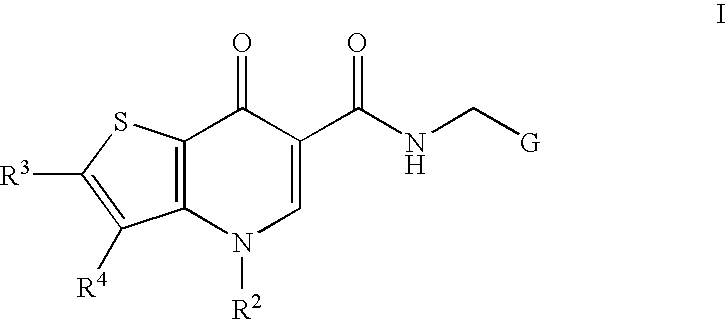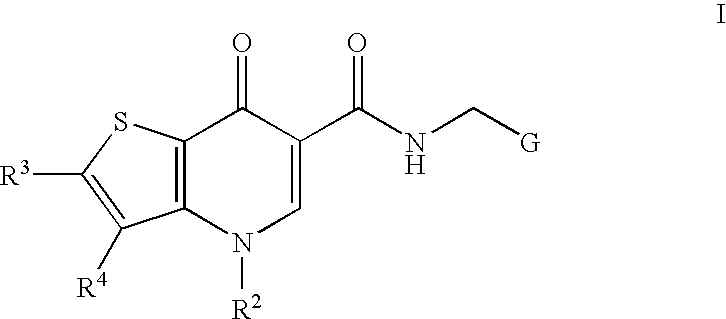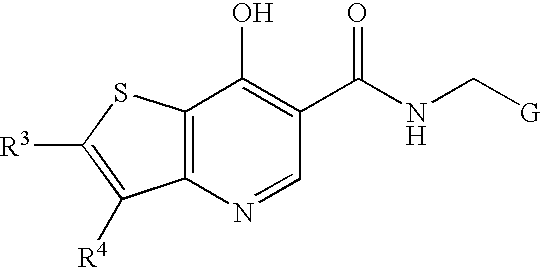Antiviral compounds
a technology of antiviral compounds and compounds, which is applied in the field of antiviral compounds, can solve the problems of high mortality in pigs under three weeks, eye and encephalitis infections, and rapid death
- Summary
- Abstract
- Description
- Claims
- Application Information
AI Technical Summary
Benefits of technology
Problems solved by technology
Method used
Image
Examples
preparation 1
Diethyl 2-{[(4-methylthien-3-yl)amino]methylene}malonate
To a solution of methyl 3-amino-4-methylthiophene-2-carboxylate (commercially available from Avocado, catalog number 10115, 5.00 g, 29.2 mmol) in 95% ethanol (25 mL) was added 1.0 N NaOH (35 mL). The mixture was heated to reflux and stirred for 2.5 hrs. The resulting solution was cooled to room temperature before the addition of glacial acetic acid (2.05 mL, 35.8 mmol). After stirring for 5 minutes at room temperature, diethyl ethoxymethylenemalonate (DEEM, 6.5 mL, 32.2 mmol) was added. The mixture was stirred vigorously until it nearly solidified (ca. 5 min), and then it was left standing at room temp for 3 hours. 95% ethanol (60 mL) was added, and the mixture was warmed on a steam bath until solution was achieved. Water (50 mL) was added with continued heating on the steam bath, resulting in a slightly cloudy solution. The flask was removed from the steam bath and allowed to cool to room temp and then placed in a 0° C. refrig...
preparation 2
Ethyl 7-hydroxy-3-methylthieno[3,2-b]pyridine-6-carboxylate
A solution of diethyl 2-{[(4-methylthien-3-yl)amino]methylene}malonate (5.79 g) in diphenyl ether (200 mL) in a 500 mL round bottom (RB) flask was degassed by three cycles of evacuation and nitrogen purge. The solution was then heated rapidly with a heating mantle to reflux and stirred at that temperature for 10 minutes. The heating mantle was removed and the golden yellow solution was then stirred for 3 hours, during which time a copious precipitate appeared. The mixture was diluted with diethyl ether (300 mL) before collecting the solid by vacuum filtration. The collected solid was washed thoroughly with ether and dried in vacuo, leaving a white solid (3.94 g).
Physical characteristics are as follows:
1H NMR (400 MHz, DMSO-d6) δ 12.6 (1 H), 8.33 (1 H), 7.69 (1 H), 4.22 (2 H), 2.35 (3 H), 1.28 (3 H); Anal Found: C, 55.61; H, 4.71; N, 5.92. MS (ESI+) for C11H11NO3S m / z 238 (M+H)+.
preparation 3
Ethyl 2-formyl-3-methyl-7-oxo-4,7-dihydrothieno[3,2-b]pyridine-6-carboxylate
A fresh solution of LDA was prepared by adding n-BuLi (1.6 M in hexanes, 7.94 mL, 12.7 mmol) to a 0° C. solution of diisopropylamine (1.95 mL, 13.9 mmol) in anhydrous THF (20 mL). The LDA solution was then added via syringe drop-wise to a suspension of ethyl 7-hydroxy-3-methylthieno[3,2-b]pyridine-6-carboxylate (1.00 g, 4.22 mmol) in THF (30 mL) at −78° C. over a period of about 10 minutes. After addition of the LDA, the solution was stirred at −78° C. for 1 hr 15 min before the drop-wise addition of dry DMF (1.63 mL, 21.1 mmol). The reaction was stirred at −78° C. for 20 minutes and then the dry ice bath was removed. The temperature was allowed to rise to over 0° C. before the reaction was quenched by the addition of sat. aqueous ammonium chloride (25 mL). Water (20 mL) and ethyl acetate (25 mL) were added, and the mixture was stirred vigorously for one hour. After standing overnight at 0° C., the solid pre...
PUM
| Property | Measurement | Unit |
|---|---|---|
| Dimensionless property | aaaaa | aaaaa |
| Dimensionless property | aaaaa | aaaaa |
| Pharmaceutically acceptable | aaaaa | aaaaa |
Abstract
Description
Claims
Application Information
 Login to View More
Login to View More - R&D
- Intellectual Property
- Life Sciences
- Materials
- Tech Scout
- Unparalleled Data Quality
- Higher Quality Content
- 60% Fewer Hallucinations
Browse by: Latest US Patents, China's latest patents, Technical Efficacy Thesaurus, Application Domain, Technology Topic, Popular Technical Reports.
© 2025 PatSnap. All rights reserved.Legal|Privacy policy|Modern Slavery Act Transparency Statement|Sitemap|About US| Contact US: help@patsnap.com



